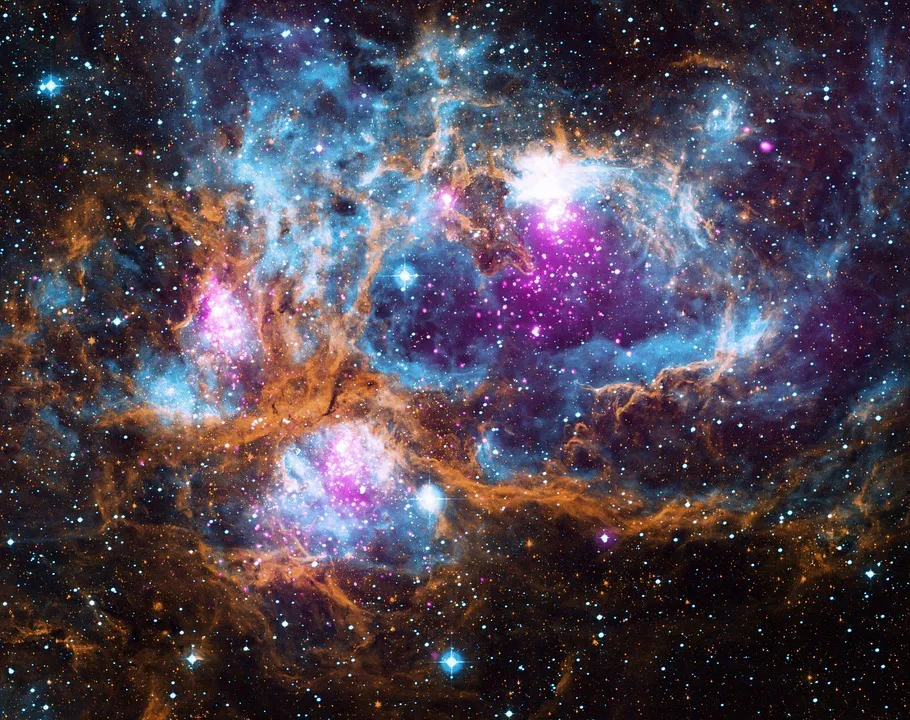
Dark matter and dark energy
Your body is made up of many different elements, all created out in the universe. But in fact, everything we can see around us is only a fraction of the material that exists in our universe
We take a closer look at dark matter, dark energy and the matter that makes up everything around us.
Your body, our planet, all the stars in the universe - are made of matter. But in addition to this matter, the universe is also made up of two other things: Dark matter and dark energy.
Today, we believe that all ‘normal’ matter only makes up about 5% of the universe. This means that everything here on Earth and everything we can see around us, both with our eyes and with telescopes - even the matter inside black holes - only makes up a very small part of the entire universe.
But what does the other 95% of the universe consist of?
Scientists believe that around 27% of the universe is dark matter and the remaining 68% is dark energy.
Dark matter
The name dark matter is a bit of a misnomer. Dark matter is not dark, but rather invisible.
We don't know much about dark matter - but we do know that it doesn't interact much with its surroundings. Dark matter doesn't absorb, reflect or emit light, making it impossible for us to observe directly.
However, we can measure the gravity of dark matter, which is how it was first discovered in the early 1900s.
Scientists looked at the movement of stars around the centre of the Milky Way and later at how other galaxies rotate around themselves. It turned out that galaxies rotate so fast that the gravity of all the dust, gas, stars and planets should not be able to hold them together. Therefore, there must be some matter that we cannot observe - and this is what we call dark matter.
Galaxies are formed
The building blocks of galaxies, stars and planets were created at the Big Bang. Back then, they were distributed almost equally throughout the universe, but very small differences in how matter was distributed meant that more dense areas collapsed due to gravity. In this way, dense areas became even denser and eventually so dense that a proto-galaxy could form - a kind of precursor to a real galaxy.
This process takes hundreds of millions of years and the first galaxies were very small compared to the galaxies we see today. As time passed, the small galaxies collided and merged into larger and larger galaxies.
Light travels at a speed of almost 300,000 km/sec, but even at this enormous speed, light from distant parts of the universe takes a long time to reach us. Light from galaxies further away has taken billions of years to reach us, which is why we see them as they looked a long time ago. By looking at galaxies at different distances from us, we can see what galaxies looked like at different times in the history of the Universe. In this way, we can get a picture of how galaxies form and evolve.

Dark energy and dark matter are two very different things. The only thing they have in common is the name, because both cannot be seen directly and have been named ‘dark’.
Dark energy
In 1929, astronomer Edwin Hubble took a closer look at some distant galaxies and found a correlation between their distance from us and the speed at which they were travelling away from us. The further away they are from us, the faster they are travelling. This means that the Universe is expanding.
In the 1990s, there was a widespread theory that the expansion of the Universe would slow down at some point because the amount of matter was so great that gravity would slow the expansion and perhaps even lead to the collapse of the Universe. This theory is called ‘The Big Crunch’.
But in 1990, the Hubble Space Telescope was launched, allowing us to see further into the Universe than ever before. The further out into the Universe you look, the further back in time you see, because the light from distant galaxies has taken millions of years to reach us. The Hubble telescope looked at the distant galaxies and found that the Universe once expanded more slowly. But that would mean that the Universe is not just expanding, but that this expansion is actually accelerating.
Scientists aren't quite sure what is causing the Universe to expand faster and faster when gravity should be causing it to contract. The force that works against gravity has a name: Dark energy. We know very little about dark energy because we can't observe it. We can only look at how it affects the visible Universe.
The future of the Universe
The balance between dark matter and dark energy is crucial to the evolution of the universe. We know so little about both that it's very difficult to predict exactly what will happen to our universe in the future. Nevertheless, scientists have made a few predictions about the fate of the universe.
Big crunch
If there isn't enough dark energy in the universe, the gravitational pull of dark matter and ordinary matter can stop the expansion and eventually pull the universe back together in a kind of reverse Big Bang.
Big Chill
If dark energy wins the tug-of-war with dark matter, our universe will continue to expand and all galaxies will be so far apart that eventually we won't be able to see the light from the other galaxies. Stars will continue to form for another trillion years or so, but then there will be no more gas left and the universe will go dark as stars are extinguished one by one.
Other fates
Since we don't know what dark matter or dark energy is, it's impossible to know what will happen to the universe in the future. Therefore, there are many different possibilities. Maybe our universe will disappear as suddenly as it came, or maybe there are many more universes than just our own?







